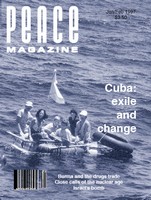
Peace Magazine Jan-Feb 1997, page 22. Some rights reserved.
Search for other articles by Mitch Dykstra here
Canada may become a participant in the United States military's "Star Wars" ballistic missile defence programs, after a low-key revision of the NORAD agreement between the two governments in March 1996. That was the message given by Ann Denholm Crosby, associate professor at York University and associate of the York Centre for International and Security Studies, and Bill Robinson, defence and security policy researcher at Project Ploughshares, at a Nov. 14 Science for Peace lecture at the University of Toronto. According to the speakers, the Canadian military establishment has been very eager to follow this path.
The U.S. government has legislated and funded three major (non-nuclear) programs which fit the Star Wars description. The first is the National Missile Defence System. It envisages land-based missiles designed to intercept incoming missiles. Its primary purpose would be to protect the U.S. from accidental launchings, "Third World aggressors," and terrorist attacks. This system should be operational on a multisite basis by 2003. Although there has been no talk so far of basing any of the missles in Canada, participation would at the least entail reprogramming of the interceptors to cover Canadian territory. According to analysts, such a multi-site system would violate the Anti Ballistic Missile (ABM) Treaty.
The second program is called the Theatre Missile Defence System. It would be used against cruise and short- to medium-range ballistic missiles for regional security around the world. A primary concern would also be defence of the U.S. against missiles launched by submarines. The system is partly operational, in the sense that similar capabilities allowed U.S. forces in the Gulf War to intercept and destroy Scud missiles.
In a fully-implemented version of this system, satellites, observation points, and ships would inform the NORAD-U.S. Space Command headquarters in Colorado Springs of hostile actions; a missile response would follow within four minutes. U.S. advocates of the system argue that it does not violate the ABM treaty, as that treaty refers to intercontinental ballistic missiles alone.
The third system is the Global Warning Program, under which the U.S. would share defence information with other countries. These other countries would obviously have to be friendly to the U.S. and be prepared to launch defensive strikes of their own in response to identified threats.
To date, a total of $17 billion US. has been spent on these systems and a further $50 billion U.S. is expected to be spent by 2010.
All of these programs have been undertaken because of a belief in U.S. defence circles that multilateral diplomacy is not working to keep the peace. The U.S. hopes that such systems will lend stability to international relations and protect peacekeepers. Further, the systems are seen by the U.S. as being defensive restraints on nuclear proliferation.
U.S. strategists are pushing for Canadian participation as this would make the systems fully North American in character and give some multinational credibility to an essentially U.S.-led defence strategy. The U.S. has assumed Canada's interest in the scheme because the systems would protect Canada, because of Canadian participation in the Gulf War, and because Canada signed the rewritten NORAD Agreement. For its part, the Canadian government has not objected to this line of thinking because it presumes part of the $50 billion would be spent in Canada, because Canada needs to know what is happening in defence in the U.S., and because the Canadian military believes participation will make Canada a space power.
Nevertheless, while the NORAD Agreement of March 1996 is a fait accompli, Canadian participation in the three programs has not been initiated. The Canadian government should speak up now if it has objections or changes to propose. Bill Robinson notes that "Canada will be obliged to participate long before there is a political decision" if something is not done in the meantime to derail the process.
The process to date has been centred around the new NORAD Agreement. It was quietly renegotiated and the hearings held in Canada were closed to the public. The agreement addresses the need for "aerospace warning and control for North America" - "control" is a new word in the agreement and another new word, "for," allows the control to be exercised anywhere in the world or in space. There is also language to allow NORAD (that is, Canadian) personnel access to previously restricted areas of the combined NORAD-U.S. Space Command headquarters, and language which allows Canadian participation in the examination of other non-NORAD programs, which in effect allows Canada to participate in the planning of the new systems as well as any number of other matters. Lastly, there is wording to enable NORAD personnel to support the missions of other commands - for instance, the Global Warning Program - and to do so without consultation.
The Science for Peace seminar highlighted two general areas of concern: that the wielding of such power ought to be multilateral, under the control of the United Nations, rather than in the hands of one superpower, with or without Canadian participation; and that the issue needs to be put before the Canadian public at once, certainly before any commitments are made by the Canadian government or undue assumptions are made by the U.S. goverment.
Foreign Affairs Minister Lloyd Axworthy has asked the public to participate in a review by the Foreign Affairs and International Trade Committee of Canada's nuclear policies. The participants on Nov. 14 agreed that the Star Wars defences and the new NORAD Agreement should be vigorously pursued in any such review.
J. M. Dykstra is an associate editor of Peace Magazine.

Peace Magazine Jan-Feb 1997, page 22. Some rights reserved.
Search for other articles by Mitch Dykstra here